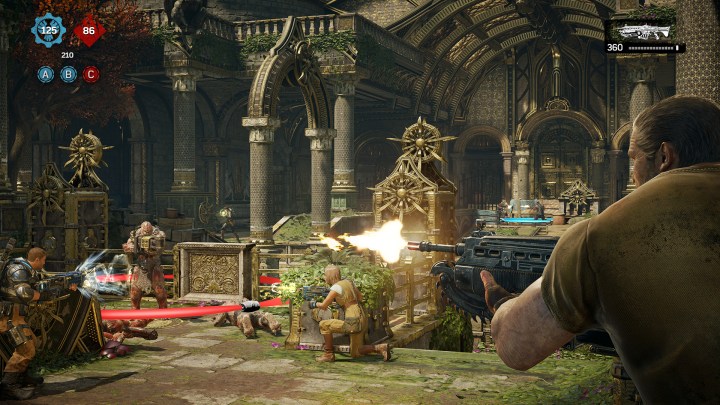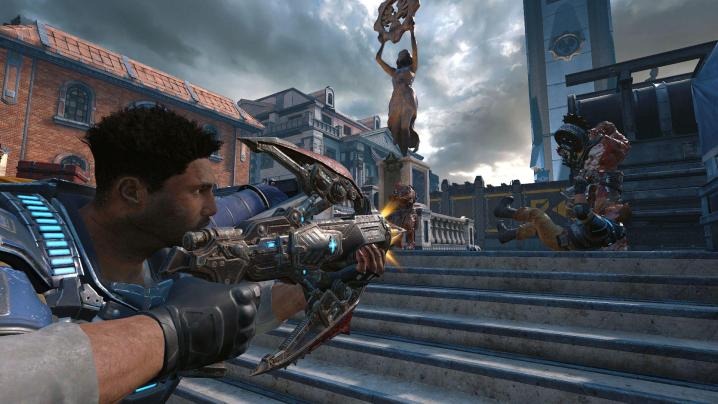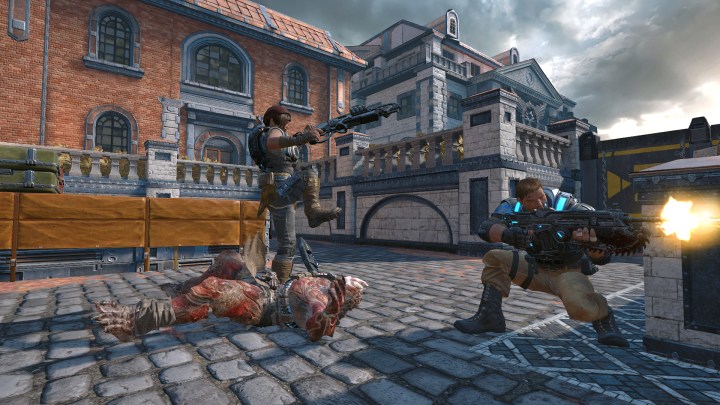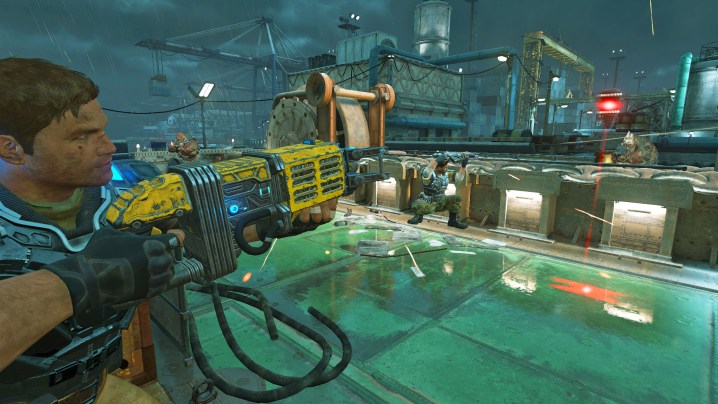
In some ways Gears 4’s PvP is the same bloody crucible it’s always been. The Gnasher shotgun still reigns supreme, skilled movement is key, and your screen gets splattered with bloody bits regularly (yours and your enemies’ alike). However, there’s enough new in Gears of War 4 that even longtime Gears players could benefit with an explanation, not to mention a few tips.
Whether this is your first Gears of War or you’ve been wall-bouncing for years, our Gears of War 4 multiplayer guide should get you started on the right frag.
Getting started in Gears of War 4 PvP
Let’s start with the basics. Gears of War 4 pits two teams, usually consisting of five players each, against each other. The weapons, maps, and modes can vary wildly, but the goal is generally the same; keep killing the other team until you win. You can play locally over a LAN connection or splitscreen, offline with computer-controlled bots, in private matches with friends, online against strangers, and in multiple different combinations of those (for example playing splitscreen with a friend and hopping into an online playlist).
You may feel like you understand how to play Gears of War 4 because you finished the campaign or played a bit of horde mode, but PvP is a very different game with its own demands and skills to master. Keep these general tips in mind before you start:
Get comfortable: You’re not going to hop into Gears 4 multiplayer for a quick game before work. Single matches in many modes can last as long as 45 minutes, so get comfortable and hunker down for long sessions.
Equip a bounty: New to Gears 4, players can take on “bounties,” which offer in-game currency in exchange for achieving specific in-game goals. Make sure you have a beneficial bounty card equipped before jumping into a match. Many bounty cards only work in specific modes, so don’t equip a “King of the Hill” bounty if you’re playing “Escalation.”
Change loadouts: Before a game starts you can often change your loadout slightly by pressing “Y.” Want to start with the Hammerburst or the Lancer? You decide.
Stick with your team: It can be tempting to go off alone to try to flank your opponents, but in team game modes it’s almost always better to stick with your squad. Doing so without support is a great way to get picked off in “Dodgeball,” or cause your team to lose objectives because you wandered off. If you want to try something fancy like a flank, get on the mic and sound off to your teammates.

Use the Gnasher: There are a lot of different weapons in Gears 4, but, as in the previous games, the Gnasher shotgun still trumps them all. Master getting in close and one-shotting opponents, and you’ll be off to a good start.
“Competitive” vs. “Core”: Weapon balance can vary depending on the playlist you’re in; Gears 4 features both “core” and “competitive” tuning. In competitive tuning modes weapons generally do less damage individually and aim assist is reduced to make up for the high skill factor in competitive play. Read more about the details of the two tunings on the official Gears of War blog.
Active reload forever: The Gears of War series’ famous active reload system has changed a little bit in Gears of War 4. Active reloads give you bonus damage if you hit the reload button again at the exact right time. In Gears 4, you can active reload whenever you want, even when the weapon’s magazine is already full. There’s then a cooldown before you can do it again. It’s a big change but one Gears 4 players are acclimating to.
Wall bouncing: Another staple tactic returning to Gears 4 multiplayer is the wall bounce. This technique lets you move across a map with great agility by lunging into cover, then strategically canceling that movement just before posting up against a wall to increase your movement speed. It’s easy to do but hard to master.
Keep it in context: If you want to come out on top in Gears 4 multiplayer don’t forget to use special context-sensitive maneuvers available to you, like the ability to grab people who are on the other side of cover from you, yank them to your side and stab them in the face. They can be quite useful when an opportunity presents itself.
Get to know the maps: There are currently 10 maps in Gears of War 4, with plans to add at least another 24 as DLC. That’s a lot of battlefield to keep track of in your head. Luckily they’re all similar: Most maps are symmetrical, with players spawn point on either side, and power weapons to pick up in the middle.
To give yourself an edge, open the scoreboard while playing on a map, then press the “B” button to see an overhead view of the level. Use that to quickly get the lay of the land. It pays to know where power weapons spawn and keep various routes in mind. Over time, you will learn the nuances of each map and have a serious advantage.
Gears of War 4 multiplayer modes
There are some really creative new modes in Gears 4 PvP, which adds lots of variety to Versus. It also makes it crucial to have a strong understanding of every mode. Here’s a quick rundown of what you’ll be doing in each one:
King of the Hill: Two teams compete to capture and hold zones around the map. Whichever team holds the capture zone gradually builds points. The twist in Gears 4 is that the capture zone moves around, with a visible countdown and an indicator showing where the next zone will appear. If your opponents hold the zone but the countdown is almost down to zero, don’t bother trying to capture it; move straight to the next zone instead.
Escalation: “Escalation” is Gears’ take on three-point “King of the Hill,” which has become a staple of shooters like Call of Duty and Titanfall. The big game-changer here is if a team captures all three points they win the round outright, making incredible comebacks a regular occurance.
Dodgeball: “Dodgeball” matches begin as 5-on-5 elimination bouts, but get tricky once players start dropping. If you’re killed, you won’t respawn until your team kills a member of the opposition. The push and pull of each team’s number makes for tense fights and awesome comebacks: If your team is down two against four, and the two remaining players get a kill, one member of your team comes back into the fray, making it three against three.

Team Deathmatch: The classic shooter mode, but instead of earning points for kills and competing to reach a certain score, but also to deplete the opposing team’s’ pool of respawns. All players who are dead at any time respawn together in waves every 15 seconds, but your team’s respawns are limited, so staying alive is the most important factor.
Arms Race: “Arms race” is one of the most creative modes in Gears 4. Both teams start with the same single weapon. Once a team gets three kills collectively with that weapon that team moves on to a new one. This cycle continues with various weapons as a sort of race, where the first team to get three kills with the final weapon wins. This creates interesting disparities where, for example, one team is trying to get longshot sniper kills while the other team rushes them with shotguns, so there are opportunities to catch up.
Guardian: In “Guardian,” one player on each team is the leader, and killing that leader prevents the other team members from respawning. You have to take out the leader to defeat the other team.
Warzone: “Warzone” is classic elimination: kill all the players on the other team to win a round. There are no respawns.
Execution: Similar to “Warzone,” but to kill an opponent you have to get up close and execute them. Brutal.
A playlist for every style
Hitting “versus” on the main menu is only the first step to actually getting into a Gears of War 4 PvP game. From there, there are seven options. The bottom one lets you manage your bounties, while the other six are different versus playlists. Here’s what they all mean:
Social quickplay: This drops you quickly into the first available game in a range of modes and on a variety of maps. The constant here, though, is that weapons are balanced with “core” (not “competitive”) tuning. Plus, the maximum squad size is two players, so you won’t run into any teams of five friends rolling all over everyone they face. It’s the casual player’s battlefield.
Core Modes: In the core modes playlist you get just that: “Team Deathmatch,” “Dodgeball,” “King of the Hill,” “Arms Race,” “Guardian,” and “Warzone.” These modes all use “core” weapon tuning by default, but there’s no limit on squad size in this playlist, so you can charge into battle with all your friends. Unlike the social quickplay playlist, players in core modes are ranked by skill.

Competitive Modes: The competitive playlist features only two modes: “Escalation” and “Execution,” both of which use competitive weapon tuning, which means lower weapon damage and less aim assist. This is where hardcore Gears 4 players practice for the big leagues. Competitive modes players are also ranked.
Co-op Modes: Co-op modes pit you and other players on a team against computer-controller bots, so you can get a taste of Gears 4 versus without having to compete against other human players. Great for Gears fans who don’t want to receive any messages about their mothers.
Private match: Just what it sounds like: host a private match and invite up to nine friends (plus two spectating), or fill it with bots. You choose the maps, modes, weapon tuning, and a variety of other options.
Play on LAN: For hardcore players who are willing to get a bunch of friends and Xbox Ones together in the same room. You ensure zero latency by playing LAN games, but it’s a lot of work.
The right tool
Gears of War 4 has an impressive variety of weapons. Sure, you’ll pretty much win every fight if you just master the Gnasher, but where’s the fun in that? Here are some recommendations for each weapon in the game, starting with the basics:
Lancer: The default tried-and-true weapon of the Gears franchise — an assault rifle with a built-in chainsaw — is the starting weapon in most modes. Concentrate fire on players who aren’t in cover, or use it to suppress those who are. Focusing fire with teammates is a quick way to down opponents, but don’t try using the chainsaw except on player’s you’ve snuck up on.
Retro lancer: The “Retro Lancer” is the less cool version of the actual Lancer, with a bayonet instead of a chainsaw. You can charge opponents with it, but why would you when you could be sawing them in half?
Gnasher: The Gnasher is the ultimate close-up tool and the main weapon in most Gears 4 matches. You have to get in really close to turn foes into bloody chunks with a single shot, but mastering that art while bouncing around the map will make you a winner.
Snub pistol: The Snub is the default pistol. It can do some damage if you nail the active reload, but it should only be used as a last resort.
Boltok: The Boltok, a revolver-style pistol, can sometimes be grabbed around the map. It does more damage than the snub and is generally more deadly.
Hammerburst: The Hammerburst assault rifle can be picked up around a map or chosen as an alternate starting weapon. High-accuracy shooters might prefer it over the Lancer because of it fires multi-round bursts, and is slightly more accurate at longer range. Like the Lancer, it’s most effective when you’re coordinating with teammates.

Enforcer: The Enforcer, Gears of War 4’s new sub-machine gun, is also a starting weapon option. Its range is worse than the Lancer and Hammerburst, and I personally haven’t found much use for it.
Overkill: The Overkill is a new type of shotgun that does less damage per shot than the Gnasher, but has better range and an incredibly fast fire rate. In the right hands it can be deadly, but it’s also easy to waste the whole magazine if you’re not aiming carefully, leaving you open to attack.
Markza MK1: The game’s only true marksman rifle that isn’t a sniper, the Markza rewards accuracy by letting you kill at greater range than the lancer or hammerburst. Its magazine is limited, though, so every shot counts and active reloads are crucial.
Then there are the power weapons, which you can find scattered around the map in most modes:
Torque bow: The Torque Bow requires good accuracy and timing, as it requires you to hold down the trigger to charge a shot and release it while aiming at an enemy. If you stick the landing, though, it’s a one hit kill from any range.
Dropshot: The Dropshot is another weapon that’s extra challenging to use. Hold the trigger down to launch a projectile that speeds horizontally along the ground, then release the trigger to send the missile straight downward. You can often get a kill by hitting near an enemy, but a true master will get the satisfaction of sending it burrowing straight into an enemy’s skull.
Boomer: A Gears classic, the Boomer grenade launcher requires a reload after every shot, but offers a high degree of accuracy and the ability to lead your target skillfully, since the projectile moves relatively slowly once fired.
Longshot: One of two sniper rifles, the Longshot gets one round in the chamber at a time — who designed these weapons anyway? — but can cause massive damage with a headshot or an active reload.
Embar: The other sniper rifle is both more and less forgiving than the Longshot. It has three rounds in the chamber so you don’t need to reload as frequently, but you need to charge up a shot to use it, so it requires good aim and timing.
Mulcher: The Mulcher is a heavy chain gun you can carry around. It slows you down and prevents you from dodging, but you can still roadie-run and duck into cover. It can be devastating, but at the expense of mobility and making yourself more vulnerable.
RL-4 Salvo: The Salvo is a portable missile launcher that can do massive damage to enemies, even those in cover. Like the Mulcher, it limits your movement, but it’s still worth grabbing if you ever see it.
Tri-shot: The Tri-Shot rotating chain gun is more accurate than the mulcher, but its fire rate decreases the longer you sustain holding down the trigger, so you have to manage it carefully.
Buzzkill: The Buzzkill shoots saw blades that can chop enemies up, but it’s difficult to aim and the blades often seem to have a will of their own. It’s worth taking the time to master, however, because you can bounce shots off walls to hit enemies around corners and behind cover.
Finally there are a variety of grenades in Gears 4. Remember that you can throw these with the right trigger, aim them by holding the left trigger, or stick them to opponents or walls with the melee button:
Smoke grenades: Throwing smoke can cover your movements and give you an opening to move around when pinned behind cover or to grab a power weapon. A well place shot can also stun enemies if they go off near them.
Frag grenades: The “standard” grenade goes off with a blast that can bring opponents to their knees or blow them into tiny chunks. They’re great for planting on enemies that get in close; just make sure you dodge away before they go off.
Shock grenades: Shock grenades slow down and damage enemies that are stuck within their zapping radius, making them great for area control and pinning down your opponents. Throw them at downed opponents also makes it more difficult for them to revive.
Incendiary grenades: These blanket an area in deadly fire when they go off. A direct hit can cause a foe to burn to death, which is oddly satisfying (though a little disturbing) to watch.
Gears of War 4 versus is not for everyone, but for those that thrive on Longshot head-pops and dancing Gnasher duels, there’s nothing better. Keep these tips in mind and you’ll be ranking up in no time.
Editors' Recommendations
- Cities: Skylines II beginner’s guide: tips and tricks to get started
- Best Diablo 4 Necromancer builds: recommended skills, passives, and gear
- Resident Evil 4 Shooting Gallery guide: locations, rewards, and tips
- Resident Evil 4 remake: egg Hunt guide
- One Piece Odyssey: tips and tricks to get started


